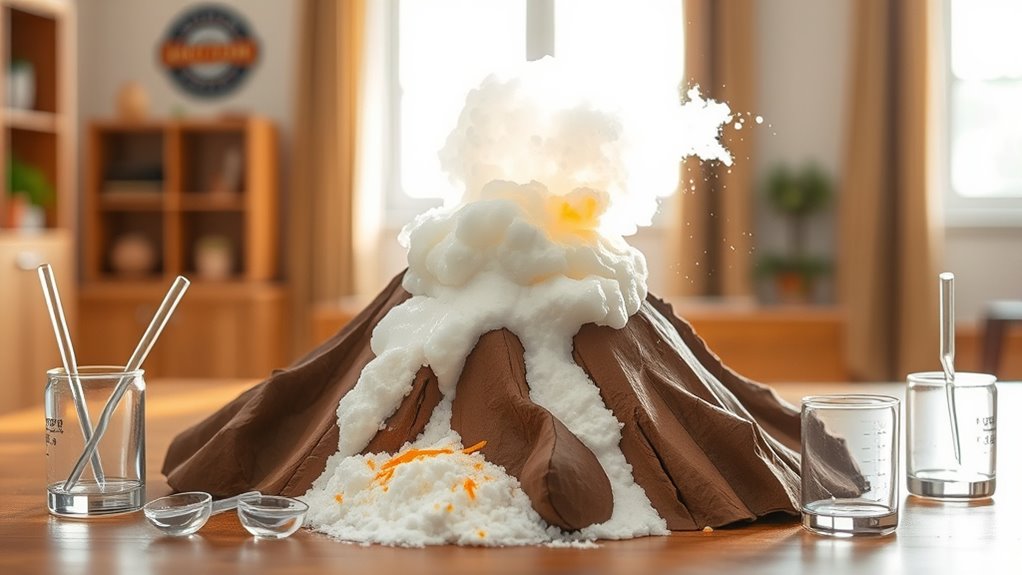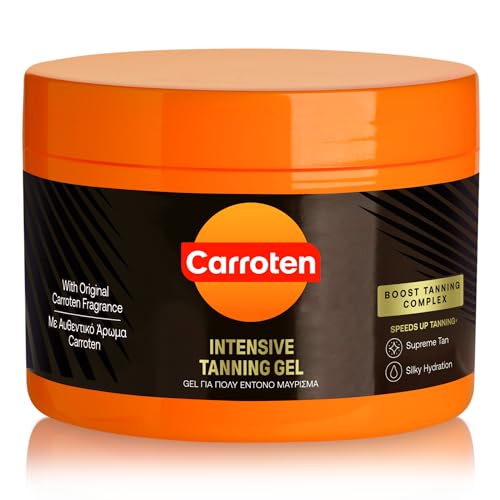A baking soda volcano experiment is a fun way to see a chemical reaction in action. When you combine baking soda with vinegar, it quickly produces carbon dioxide gas, which creates bubbles and causes a fizzy eruption. You control the timing by how quickly you pour the vinegar and how much you use. If you want to make your eruption more colorful or longer-lasting, you can add food coloring or dish soap. Keep exploring, and you’ll discover even more exciting ways to make your volcano erupt!
Key Takeaways
- The baking soda volcano creates a fizzy eruption by reacting baking soda with vinegar, producing carbon dioxide gas.
- Control eruption timing by pouring vinegar quickly or slowly, affecting the size and vigor of the eruption.
- Enhance visual appeal by adding food coloring and dish soap for colorful, longer-lasting foam.
- Vary amounts of reactants to observe different eruption sizes and learn about chemical reaction variables.
- This simple experiment offers an engaging way to demonstrate chemical reactions and gas production for educational fun.

Creating a baking soda volcano is a fun and easy science experiment that you can do at home or in the classroom. When you set up this classic project, you’re diving into the world of chemical reactions that produce a spectacular eruption. The key to making your volcano erupt convincingly lies in understanding how the chemical reactions unfold and controlling the eruption timing. Once you mix the right ingredients, you’ll see a fizzy, bubbly eruption that mimics a real volcano, providing both entertainment and educational value.
Create a fun, educational baking soda volcano to explore chemical reactions and eruption timing.
The main reaction in your baking soda volcano involves combining baking soda (sodium bicarbonate) with an acid, typically vinegar (acetic acid). When these two substances meet, they undergo a chemical reaction that releases carbon dioxide gas. This gas forms bubbles and causes the foamy eruption that pours out of your volcano. The chemical reaction is straightforward, but the timing of the eruption depends on how quickly the reactants come into contact and how much acid you add. If you add a lot of vinegar at once, you’ll get a rapid, vigorous eruption. Conversely, adding less or pouring it slowly can delay the eruption, giving you control over the timing.
To guarantee your eruption occurs at just the right moment, you should prepare the volcano structure beforehand and have your vinegar ready. Once everything is set, pour the vinegar into the volcano’s opening quickly and step back. The moment the vinegar hits the baking soda, the chemical reaction kicks in almost instantly, producing carbon dioxide gas. This gas builds up pressure inside the container until it forces the foam out with a dramatic burst. Watching the eruption unfold provides a clear visual of how chemical reactions can produce real-world effects and demonstrates the importance of timing in chemical processes.
You can experiment further by varying the amount of baking soda and vinegar to see how it affects the eruption size and timing. Adding food coloring to the vinegar can make the eruption more visually appealing, turning your volcano into a colorful spectacle. If you want to extend the experiment, try adding a small amount of dish soap to the vinegar. This traps more bubbles and results in a longer-lasting, more foamy eruption. Additionally, understanding the role of color accuracy in visual demonstrations can enhance the educational experience. These modifications help you understand the principles behind chemical reactions, gas production, and how different variables influence reaction speed and eruption timing.
Frequently Asked Questions
Can I Use Other Acids Besides Vinegar for the Eruption?
Yes, you can use alternative acids for the eruption, but make sure they are safe substitutes. Options like citric acid, lemon juice, or lime juice work well because they react with baking soda to produce a fizzing eruption. Just remember, avoid using strong or hazardous acids, and test small amounts first to guarantee safety. Always supervise children during experiments, and enjoy exploring different acids for fun science reactions.
How Long Does the Volcano Eruption Last?
The eruption lasts about 5 to 10 seconds, giving you a quick but exciting reaction time. You’ll see the bubbling, foaming, and lava-like flow, creating a dramatic display. The duration depends on how much baking soda and acid you use, as well as the reaction speed. To extend the eruption, try adding more ingredients or adjusting their amounts. This way, you can control the spectacle and enjoy the science fun longer!
Is Baking Soda Safe for All Ages?
Baking soda is generally safe for all ages when used properly, but safety concerns and age appropriateness matter. Young children should be supervised during the experiment to prevent ingestion or inhalation. Always use in a well-ventilated area, and avoid contact with eyes or skin. For very young kids, consider using smaller amounts and adult assistance to guarantee a fun, safe science experience.
Can I Make a Volcano With Materials at Home?
Yes, you can make a volcano with materials at home for safe experimentation. Gather homemade materials like vinegar, baking soda, dish soap, and red food coloring to create your eruption. Simply build a volcano shape using clay, paper mâché, or even a plastic bottle. When you combine the ingredients, it produces a fizzy, colorful eruption. This fun, safe activity is perfect for exploring simple science concepts with family or friends.
What Are the Science Principles Behind the Eruption?
The eruption happens because of a chemical reaction between baking soda and vinegar. When you mix them, they produce gas, mainly carbon dioxide, which creates pressure and causes the “volcano” to erupt. You see this gas production rapidly escaping as bubbles, pushing the foam out of the container. This simple experiment demonstrates how chemical reactions can produce gases that lead to fun, observable eruptions.
Conclusion
So, after all that fizzing and erupting, you realize this simple volcano isn’t just child’s play—it’s science magic. But don’t get too excited; this tiny eruption probably won’t change the world. Still, you’ve created a mini masterpiece, proving that even the simplest ingredients can cause a big splash. Sometimes, the biggest reactions come from the smallest things—just like your little volcano. Who knew science could be so unexpectedly fun?










